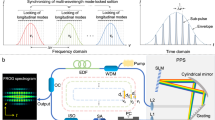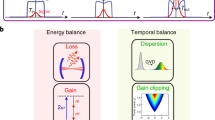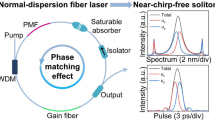Abstract
Ultrashort pulse generation hinges on the careful management of dispersion. Traditionally, this has exclusively involved second-order dispersion, with higher-order dispersion treated as a nuisance to be minimized. Here, we show that this higher-order dispersion can be strategically leveraged to access an uncharted regime of ultrafast laser operation. In particular, our mode-locked laser—with an intracavity spectral pulse shaper—emits pure-quartic soliton pulses that arise from the interaction of fourth-order dispersion and the Kerr nonlinearity. Phase-resolved measurements demonstrate that their pulse energy scales with the third power of the inverse pulse duration. This implies a strong increase in the energy of short pure-quartic solitons compared with conventional solitons, for which the energy scales as the inverse of the pulse duration. These results not only demonstrate a novel approach to ultrafast lasers, but more fundamentally, they clarify the use of higher-order dispersion for optical pulse control, enabling innovations in nonlinear optics and its applications.
This is a preview of subscription content, access via your institution
Access options
Access Nature and 54 other Nature Portfolio journals
Get Nature+, our best-value online-access subscription
$29.99 / 30 days
cancel any time
Subscribe to this journal
Receive 12 print issues and online access
$209.00 per year
only $17.42 per issue
Buy this article
- Purchase on Springer Link
- Instant access to full article PDF
Prices may be subject to local taxes which are calculated during checkout




Similar content being viewed by others
Data availability
The data that support the plots in this paper and other findings of this study are available from the corresponding author on reasonable request.
References
Mollenauer, L. F., Evangelides, S. G. & Haus, H. A. Long distance soliton propagation using lumped amplifiers and dispersion shifted fiber. J. Lightwave Technol. 9, 194–197 (1991).
Mollenauer, L. F. et al. Demonstration of error-free soliton transmission at 2.5 Gbit/s over more than 14,000 km. Electron. Lett. 27, 2055–2056 (1991).
Haus, H. A. & Wong, W. S. Solitons in optical communications. Rev. Mod. Phys. 68, 423–444 (1996).
Husakou, A. V. & Herrmann, J. Supercontinuum generation of higher-order solitons by fission in photonic crystal fibers. Phys. Rev. Lett. 87, 203901 (2001).
Dudley, J. M., Genty, G. & Coen, S. Supercontinuum generation in photonic crystal fiber. Rev. Mod. Phys. 78, 1135–1184 (2006).
Xu, C. & Wise, F. W. Recent advances in fibre lasers for nonlinear microscopy. Nat. Photon. 7, 875–882 (2013).
Cundiff, S. T. & Ye, J. Colloquium femtosecond optical frequency combs. Rev. Mod. Phys. 75, 325–342 (2003).
Jung, I. D. et al. Self-starting 6.5-fs pulses from a Ti:sapphire laser. Opt. Lett. 22, 1009–1011 (1997).
Mollenauer, L. F. & Stolen, R. H. The soliton laser. Opt. Lett. 9, 13–15 (1984).
Kafka, J. D., Baer, T. & Hall, D. W. Mode-locked erbium-doped fiber laser with soliton pulse shaping. Opt. Lett. 14, 1269–1271 (1989).
Matsas, V. J., Newson, T. P. & Zervas, M. N. Self-starting passively mode-locked fibre ring laser exploiting nonlinear polarisation switching. Opt. Commun. 92, 61–66 (1992).
Zakharov, V. E. & Shabat, A. B. Exact theory of two-dimensional self-focusing and one-dimensional self-modulation of waves in nonlinear media. Sov. Phys. JETP 34, 62–69 (1972).
Hasegawa, A. & Tappert, F. Transmission of stationary nonlinear optical pulses in dispersive dielectric fibers. I. Anomalous dispersion. Appl. Phys. Lett. 23, 142–144 (1973).
Kelly, S. M. J. Characteristic sideband instability of periodically amplified average soliton. Electron. Lett. 28, 806–808 (1992).
Chong, A., Buckley, J., Renninger, W. & Wise, F. All-normal-dispersion femtosecond fiber laser. Opt. Express 14, 10095–10100 (2006).
Regelskis, K., Želudevičius, J., Viskontas, K. & Račiukaitis, G. Ytterbium-doped fiber ultrashort pulse generator based on self-phase modulation and alternating spectral filtering. Opt. Lett. 40, 5255–5258 (2015).
Zhou, J. et al. Pulse evolution in a broad-bandwidth Ti:sapphire laser. Opt. Lett. 19, 1149–1151 (1994).
Christov, I., Murnane, M. N., Kapteyn, H. C., Zhou, J. & Huang, C.-P. Fourth-order dispersion-limited solitary pulses. Opt. Lett. 19, 1465–1467 (1994).
Höök, A. & Karlsson, M. Ultrashort solitons at the minimum-dispersion wavelength: effects of fourth-order dispersion. Opt. Lett. 18, 1388–1390 (1993).
Kodama, Y., Romagnoli, M., Wabnitz, S. & Midrio, M. Role of third-order dispersion on soliton instabilities and interactions in optical fibers. Opt. Lett. 19, 165–167 (1994).
Blow, K. J., Doran, N. J. & Wood, D. Generation and stabilization of short soliton pulses in the amplified nonlinear Schrödinger equation. J. Opt. Soc. Am. B 5, 381–391 (1988).
Karlsson, M. & Höök, A. Soliton-like pulses governed by fourth order dispersion in optical fibers. Opt. Commun. 104, 303–307 (1994).
Akhmediev, N., Buryak, A. V. & Karlsson, M. Radiationless optical solitons with oscillating tails. Opt. Commun. 110, 540–544 (1994).
Roy, S. & Biancalana, F. Formation of quartic solitons and a localized continuum in silicon-based waveguides. Phys. Rev. A 87, 025801 (2013).
Blanco-Redondo, A. et al. Pure-quartic solitons. Nat. Commun. 7, 10427 (2016).
Lo, C. W., Stefani, A., de Sterke, C. M. & Blanco-Redondo, A. Analysis and design of fibers for pure-quartic solitons. Opt. Express 26, 7786–7796 (2018).
Tam, K. K. K., Alexander, T. J., Blanco-Redondo, A. & de Sterke, C. M. Stationary and dynamical properties of pure-quartic solitons. Opt. Lett. 44, 3306–3309 (2019).
Taheri, H. & Matsko, A. B. Quartic dissipative solitons in optical Kerr cavities. Opt. Lett. 44, 3086–3089 (2019).
Knox, F. M., Forysiak, W. & Doran, N. J. 10 gbit/s soliton communication systems over standard fibre at 1.55 m and the use of dispersion compensation. IEEE J. Lightwave Technol. 13, 1955–1962 (1994).
Turitsyn, S. K., Bale, B. G. & Fedoruk, M. P. Dispersion-managed solitons in fibre systems and lasers. Phys. Rep. 521, 135–203 (2012).
Agrawal, G. P. Nonlinear Fibre Optics (Academic Press, 1995).
Schröder, J., Coen, S., Sylvestre, Th. & Eggleton, B. J. Dark and bright pulse passive mode-locked laser with in-cavity pulse-shaper. Opt. Express 18, 22715–22721 (2010).
Peng, J. & Boscolo, S. Filter-based dispersion-managed versatile ultrafast fibre laser. Sci. Rep. 6, 25995 (2016).
Dorrer, C. & Kang, I. Simultaneous temporal characterization of telecommunication optical pulses and modulators by use of spectrograms. Opt. Lett. 27, 1315–1317 (2002).
Hammani, K. et al. Peregrine soliton generation and breakup in standard telecommunications fiber. Opt. Lett. 36, 112–114 (2011).
Ito, T., Slezak, O., Yoshita, M., Akiyama, H. & Kobayashi, Y. High-precision group-delay dispersion measurements of optical fibers via fingerprint-spectral wavelength-to-time mapping. Photon. Res. 4, 13–16 (2016).
Oktem, B., Ülgüdür, C. & Ilday, F. Ö. Soliton–similariton fibre laser. Nat. Photon. 4, 307–311 (2010).
Woodward, R. I. Dispersion engineering of mode-locked fibre laser. J. Opt. 20, 033002 (2018).
Dennis, M. L. & Duling, I. N. Experimental study of sideband generation in femtosecond fiber lasers. IEEE J. Quant. Elect. 30, 1469–1477 (1994).
Tamura, K., Ippen, E. P., Haus, H. A. & Nelson, L. E. 77-fs Pulse generation from a stretched-pulse mode-locked all-fiber ring laser. Opt. Lett. 18, 1080–1082 (1993).
Chen, Y. et al. Dispersion-managed mode locking. J. Opt. Soc. Am. B 16, 1999–2004 (1999).
Blanco-Redondo, A., de Sterke, C. M., Husko, C. & Eggleton, B. J. High-energy ultra-short pulses from pure-quartic solitons. In 2017 European Conference on Lasers and Electro-Optics and European Quantum Electronics Conference EE_3_2 (Optical Society of America, 2017).
Marin-Palomo, P. et al. Microresonator-based solitons for massively parallel coherent optical communications. Nature 546, 274–279 (2017).
Trebino, R. Frequency-Resolved Optical Gating: The Measurement of Ultrashort Laser Pulses (Springer, 2000).
Acknowledgements
This work was supported by the Australian Research Council (ARC) Discovery Project (grant no. DP180102234), the University of Sydney Professor Harry Messel Research Fellowship and the Asian Office of Aerospace R&D (AOARD) (grant no. FA2386-19-1-4067).
Author information
Authors and Affiliations
Contributions
A.B.-R., C.M.d.S. and D.D.H. conceived the idea of the PQS laser. A.F.J.R., D.D.H. and A.B.-R. designed the experiment. A.F.J.R. performed the experiments and the numerical simulations. K.K.K.T. and C.M.d.S. carried out the theoretical analysis. C.M.d.S. and A.B.-R. supervised the overall project. All the authors contributed to the interpretation of data and wrote the manuscript.
Corresponding author
Ethics declarations
Competing interests
A.F.J.R., D.D.H., C.M.d.S. and A.B.-R. have submitted a provisional patent application based on the ideas presented in this work.
Additional information
Publisher’s note Springer Nature remains neutral with regard to jurisdictional claims in published maps and institutional affiliations.
Supplementary information
Supplementary Information
Supplementary Figs. 1–6, Discussion and Table 1.
Rights and permissions
About this article
Cite this article
Runge, A.F.J., Hudson, D.D., Tam, K.K.K. et al. The pure-quartic soliton laser. Nat. Photonics 14, 492–497 (2020). https://doi.org/10.1038/s41566-020-0629-6
Received:
Accepted:
Published:
Issue Date:
DOI: https://doi.org/10.1038/s41566-020-0629-6
This article is cited by
-
The bright prospects of optical solitons after 50 years
Nature Photonics (2023)
-
Dispersion-less Kerr solitons in spectrally confined optical cavities
Light: Science & Applications (2023)
-
Heteronuclear multicolor soliton compounds induced by convex-concave phase in fiber lasers
Communications Physics (2023)
-
Cubic-quintic nonlinear wave patterns and Lagrangian approach to modulational instability in pure-quartic media
Optical and Quantum Electronics (2023)
-
Nanoptera in Higher-Order Nonlinear Schrödinger Equations: Effects of Discretization
Journal of Nonlinear Science (2023)



